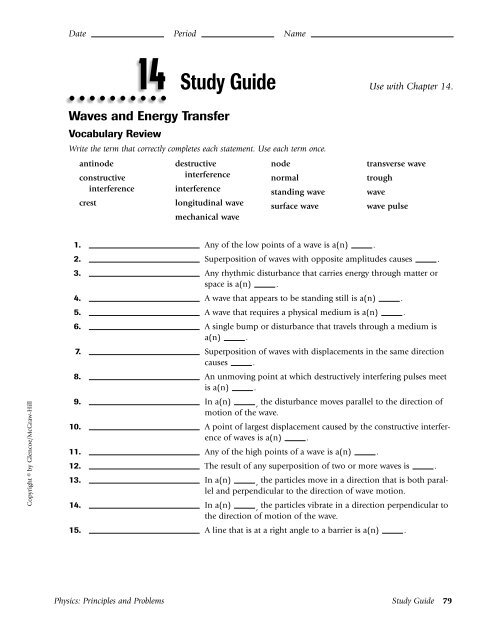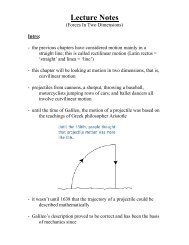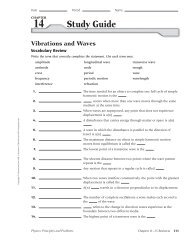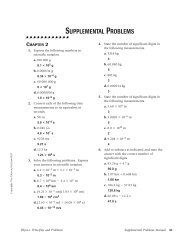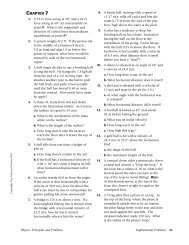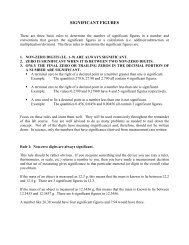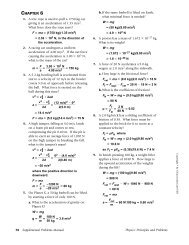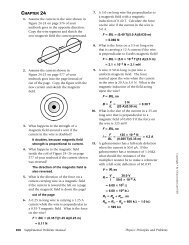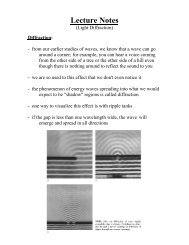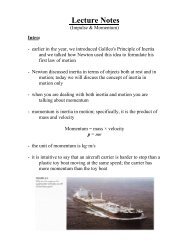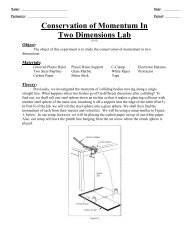Study Guide - Dickey Physics
Study Guide - Dickey Physics
Study Guide - Dickey Physics
You also want an ePaper? Increase the reach of your titles
YUMPU automatically turns print PDFs into web optimized ePapers that Google loves.
Date Period Name<br />
14<br />
<strong>Study</strong> <strong>Guide</strong> Use with Chapter 14.<br />
Waves and Energy Transfer<br />
Vocabulary Review<br />
Write the term that correctly completes each statement. Use each term once.<br />
antinode<br />
constructive<br />
interference<br />
crest<br />
destructive<br />
interference<br />
interference<br />
longitudinal wave<br />
mechanical wave<br />
node<br />
normal<br />
standing wave<br />
surface wave<br />
transverse wave<br />
trough<br />
wave<br />
wave pulse<br />
Copyright © by Glencoe/McGraw-Hill<br />
1. Any of the low points of a wave is a(n) .<br />
2. Superposition of waves with opposite amplitudes causes .<br />
3. Any rhythmic disturbance that carries energy through matter or<br />
space is a(n) .<br />
4. A wave that appears to be standing still is a(n) .<br />
5. A wave that requires a physical medium is a(n) .<br />
6. A single bump or disturbance that travels through a medium is<br />
a(n) .<br />
7. Superposition of waves with displacements in the same direction<br />
causes .<br />
8. An unmoving point at which destructively interfering pulses meet<br />
is a(n) .<br />
9. In a(n) , the disturbance moves parallel to the direction of<br />
motion of the wave.<br />
10. A point of largest displacement caused by the constructive interference<br />
of waves is a(n) .<br />
11. Any of the high points of a wave is a(n) .<br />
12. The result of any superposition of two or more waves is .<br />
13. In a(n) , the particles move in a direction that is both parallel<br />
and perpendicular to the direction of wave motion.<br />
14. In a(n) , the particles vibrate in a direction perpendicular to<br />
the direction of motion of the wave.<br />
15. A line that is at a right angle to a barrier is a(n) .<br />
<strong>Physics</strong>: Principles and Problems <strong>Study</strong> <strong>Guide</strong> 79
14<br />
<strong>Study</strong> <strong>Guide</strong><br />
Name<br />
Section 14.1: Wave Properties<br />
In your textbook, read about different kinds of waves.<br />
Circle the letter of the choice that best completes each statement.<br />
1. Waves typically transmit .<br />
a. matter only c. energy only<br />
b. both matter and energy d. neither matter nor energy<br />
2. Water waves, sound waves, and waves that travel down a spring are all examples of .<br />
a. mechanical waves c. electromagnetic waves<br />
b. transverse waves d. longitudinal waves<br />
3. If a wave moves in a leftward direction but the particles of the medium move up and down, the<br />
wave must be a .<br />
a. mechanical wave c. surface wave<br />
b. transverse wave d. longitudinal wave<br />
4. A surface wave has characteristics of .<br />
a. longitudinal waves only c. both longitudinal and transverse waves<br />
b. transverse waves only d. neither longitudinal nor transverse waves<br />
For each of the statements below, write true or rewrite the italicized part to make the statement true.<br />
5. Sound is an example of a transverse wave.<br />
6. Fluids usually transmit only longitudinal waves.<br />
7. Waves at the top of a lake or an ocean are examples of surface waves.<br />
8. Energy from the sun reaches Earth by means of longitudinal electromagnetic waves.<br />
9. Waves that travel down a rope are examples of surface waves.<br />
Copyright © by Glencoe/McGraw-Hill<br />
80 <strong>Study</strong> <strong>Guide</strong> <strong>Physics</strong>: Principles and Problems
14<br />
<strong>Study</strong> <strong>Guide</strong><br />
Name<br />
In your textbook, read about amplitude and frequency.<br />
For each of the statements below, write true or rewrite the italicized part to make it true.<br />
10. One hertz is equal to one oscillation per second.<br />
11. The speed of a wave generally depends only on the source.<br />
12. Waves with larger amplitudes tend to transmit less energy than do waves with smaller amplitudes.<br />
13. The frequency of a wave does not depend on the medium.<br />
14. A wave of high frequency also has a long period.<br />
15. The higher the frequency of a wave is, the longer the period is.<br />
In your textbook, read about measuring waves.<br />
For each term on the left, write the matching symbol from the list on the right.<br />
16. wavelength d<br />
17. period v<br />
18. speed T<br />
Copyright © by Glencoe/McGraw-Hill<br />
19. frequency t<br />
20. displacement of wave peak f<br />
21. time interval <br />
In your textbook, read about the relationship of speed to wave attributes.<br />
Use symbols to write the equation that combines the attributes on the left.<br />
22. frequency and period f <br />
23. speed, displacement, and time interval v <br />
24. speed, wavelength, and frequency v <br />
25. speed, wavelength, and period v <br />
<strong>Physics</strong>: Principles and Problems <strong>Study</strong> <strong>Guide</strong> 81
14<br />
<strong>Study</strong> <strong>Guide</strong><br />
Name<br />
In your textbook, read about measuring waves.<br />
Write the terms that correctly completes the passage.<br />
The (26)<br />
of a wave is its maximum displacement from its<br />
position of rest. Doubling the amplitude of a wave increases the rate of energy transfer by a factor of<br />
(27) . The time it takes for the motion of an oscillator to repeat itself in<br />
generating a wave is the (28)<br />
repeating, such a wave is a(n) (29)<br />
oscillations per second is the (30)<br />
of the wave. Because the motion keeps<br />
wave. The number of complete<br />
and is measured in units called<br />
(31) . Both period and frequency of a wave depend only on its<br />
(32) . A material that carries the energy of a mechanical wave<br />
is a(n) (33) .<br />
In your textbook, read about the attributes of a wave.<br />
Refer to the drawing below to answer the following questions.<br />
34. Which of the lettered distances represents<br />
the wavelength of wave 1?<br />
35. Which of the distances represents the<br />
amplitude of wave 1?<br />
A<br />
B<br />
C<br />
Wave 1<br />
36. Which of the two waves has the greater<br />
wavelength?<br />
37. Which of the two waves has the smaller<br />
amplitude?<br />
38. Assuming that the two waves move at equal<br />
speed, which has the higher frequency?<br />
39. Assuming that the two waves move at equal speed, which has the greater period?<br />
C<br />
Wave 2<br />
Copyright © by Glencoe/McGraw-Hill<br />
82 <strong>Study</strong> <strong>Guide</strong> <strong>Physics</strong>: Principles and Problems
14<br />
<strong>Study</strong> <strong>Guide</strong><br />
Name<br />
Section 14.2: Wave Behavior<br />
In your textbook, read about wave reactions to boundaries.<br />
For each of the statements below, write true or rewrite the italicized part to make it true.<br />
1. When a wave encounters the boundary of the medium in which it is<br />
traveling, the wave always reflects completely back into the medium.<br />
2. A wave that strikes a boundary is called the incident wave.<br />
3. If a wave passes from a lighter, more flexible spring to a heavier,<br />
stiffer one, the resulting reflected wave will be inverted.<br />
4. If a wave pulse is sent down a spring connected to a rigid wall,<br />
almost none of the wave’s energy is reflected back.<br />
Answer the following questions, using complete sentences.<br />
5. What happens to the wavelength of water waves as they move from deep to shallow water?<br />
6. What happens to the frequency of water waves as they move from deep to shallow water?<br />
7. What happens to the speed of water waves as they move from deep to shallow water? Describe an<br />
equation that would show this change.<br />
Copyright © by Glencoe/McGraw-Hill<br />
In your textbook, read about wave interference.<br />
For each of the statements below, write true or rewrite the italicized part to make it true.<br />
8. According to the principle of superposition, the medium’s displacement<br />
caused by two or more waves is the algebraic difference<br />
between the displacements caused by the individual waves.<br />
9. In constructive interference, the resulting wave has an amplitude<br />
smaller than that of any of the individual waves.<br />
10. Two waves cannot exist in the same medium at the same time.<br />
11. A continuous wave appears to be standing still.<br />
12. If the trough of one wave occurs at the same point as the crest of<br />
another wave, the two may cancel out, producing zero amplitude at<br />
that point.<br />
13. When a continuous wave crosses a boundary and moves more<br />
slowly, the amplitude increases.<br />
<strong>Physics</strong>: Principles and Problems <strong>Study</strong> <strong>Guide</strong> 83
14<br />
<strong>Study</strong> <strong>Guide</strong><br />
Name<br />
In your textbook, read about two-dimensional waves.<br />
Answer the following questions, using complete sentences.<br />
14. What is a ray?<br />
15. What is a ripple tank?<br />
16. State the law of reflection, and explain how each of the two kinds of angles involved are measured.<br />
17. What is meant by refraction?<br />
18. In how many dimensions do the waves travel in the following three cases: a wave moving along a<br />
rope, a wave on the surface of water, and a sound wave.<br />
In your textbook, read about diffraction and interference of waves.<br />
Write the terms that correctly complete the passage.<br />
When waves reach a small opening in a barrier, they form waves that have a(n)<br />
(19) shape. This effect is an example of (20) .<br />
The smaller the (21)<br />
is, compared to the size of the barrier, the<br />
(22) pronounced this effect is. When there are two closely spaced<br />
openings in a barrier, two sets of (23)<br />
waves are produced. Nodes lie<br />
Copyright © by Glencoe/McGraw-Hill<br />
along lines between lines of (24)<br />
. Nodes form where there is<br />
(25) interference.<br />
84 <strong>Study</strong> <strong>Guide</strong> <strong>Physics</strong>: Principles and Problems


